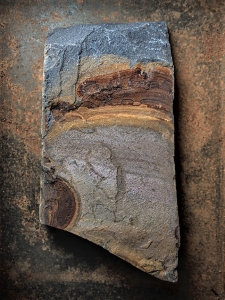The art in a weathered old rock
The Catskill Geologists; The Mountain Eagle; Dec. 20, 2019
Robert and Johanna Titus
Often, the hardest part of our writing these columns is shooting the photos. We really need good illustrations of those things that interest us if we are to explain them to you. So, it might not surprise you that, from time to time, we borrow a photo from someone who is better at picture taking than we are, especially if that person is a lot better. Have you ever seen the images done by Art Murphy? Art is a professional photographer and a good friend of ours. We like his work and respect it. He is quite unusual in that he specializes in shooting pictures of fossils. As he lives in the Catskills region, that means he mostly takes photos of Devonian aged fossil invertebrates, and he is good at it. He finds just the right fossil shellfish, catches the perfect light and color, and presto; Art has created art! He runs a blog at “https://artandfossils.wordpress.com.” Every week or so he publishes a series of his recent photos and we always find them fun to view. You might give it a try.
Recently, Art departed from his norm and ran a group of photos which showed not fossils, but the chemical weathering of stratified rocks that was going on in his favorite local quarry. We were inspired to see what we could write about some of his photos and Art generously let us use them. Today’s column shows the first.

Take a look at it; what do you see? We see two colors: a lot of yellow, forming a coating across the surface of this rock and lesser amounts of bluish gray. We think the gray is the rock itself in its natural state. Art showed us around the quarry a few years ago and that’s what we saw. We were, on that day, visiting an ancient sea floor. Those sedimentary rocks had once been sandy muds on the floor of the Devonian Catskill Sea. We saw a lot of fossils in these rocks, so we know it was a sea floor that was favorable to life, specifically there was enough oxygen in the water to support invertebrate animals. But there wasn’t much more than just that. The relatively dark color indicated that there had been some limits on the oxygen contents.
And that was the proverbial rub; these dark sediments hardened to become dark rocks, and both the original sediments and, later the rocks, reflected those limited oxygen contents. Rocks or sediments, it didn’t matter; they had only ever been stable within relatively low oxygen levels – unlike those of the modern quarry floor. Quarrying had brought dark rocks to the surface and exposed them to large amounts of atmospheric oxygen – molecular O2. That’s when chemical weathering began. The air’s moisture and oxygen “attacked” the iron bearing minerals in the rocks in a chemical process geologists call oxidation. Iron, in the rock, was converted into a mineral that is called limonite, and limonite is the yellow part of Art’s photo
Limonite is an unusual mineral. It does not have a crystalline structure; it might be described as a mishmash of iron, oxygen and hydrogen atoms. Limonite has a common name; it can be called “rust.” When the oxygen of water attacks manmade iron artifacts it is said to rust them away. In this case, the rock will never rust away. Instead, a thin yellow coating will form on the surface of the rock. Oxygen has turned the iron in the rock into limonite. Then it will sit and wait, perhaps years and decades, until just the right artist comes along.
You have learned just a little science today; that wasn’t hard, was it?
Contact the authors at randjtitus@prodigy.net. Join their facebook page “The Catskill Geologist.” Read their blogs at thecatskillgeologist.com.”





